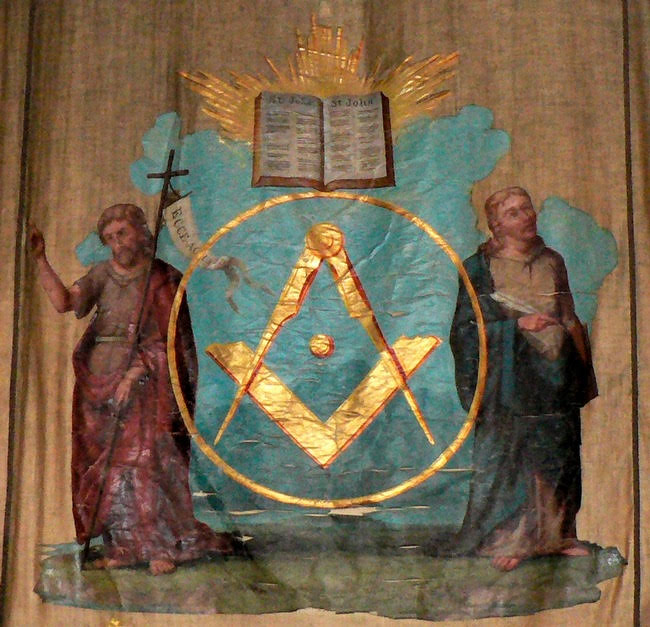Saint John the Baptist and Saint John the Evangelist are said to be the Patron Saints of Freemasonry. Combined, they are known as ‘The Holy Saints John,’ and are prominent in Ohio’s, as well as all of Freemasonry’s, ritual and degree work. In this blog we explore the histories of each Saint, and why, as Freemasons, we often reference and celebrate them.

The early adoption of The Holy Saints’ John into Freemasonry as patron Saints provides a balance or equilibrium in Masonic thought and ritual. They are introduced in the Entered Apprentice lecture. Freemasons familiar with Preston / Webb work recognize the phrase “Erected to God and dedicated to the Holy Saints John.” While very different men with different religious practices, St. John the Baptist’s more strict and rigid moral code compliments the more philosophical and esoteric work of St. John the Evangelist.
The Point Within a Circle is a symbol used by Freemasons in many jurisdictions. Some say the Point represents the individual brother on his journey of self development within the fraternity; the Circle the boundary line of his duty and an admonition to self-control. The Circle touches two parallel lines, representing St. John the Baptist and St. John the Evangelist. In passing around this circle, the individual Mason must touch both lines, opposite sides (morality and righteousness vs. brotherly love and charity) to be a well-rounded Freemason. Placed atop of this circle is the Holy Scriptures which Ohio Masons interpret as the rule and guide of faith. It is sometimes said that St. John the Baptist often represents the common gavel, square, and plumb; tools that speak to an Ohio Freemason’s desire for correctness and morality. The twenty-four inch gauge and trowel better represent St. John the Evangelist, speaking to the Freemason’s desire for brotherly love and charitable relief.
Both June 24 and December 27 are widely accepted as remembrance and recognition days to both The Holy Saints’ John. Celebrations include feasts, processions, and formal regalia. The Holy Saints’ John are often seen as metaphorical pillars of Freemasonry, with St. John the Baptist representing the pillar beneath the Earth, and St. John the Evangelist as the pillar beneath the heavens.
St. John the Baptist
St. John the Baptist lived in the early 1st century AD, and is considered a major religious figure in Christianity and Islam, among others. He is honored as a Saint in Christianity, and is considered the more prominent of the two in the Holy Gospels. According to the New Testament, as described as Jesus’ cousin, St. John the Baptist predicted His coming prepared the people for Jesus’ ministry. He is sometimes noted as Jesus’ forerunner as ordained by God, and many scholars agree that John the Baptist actually baptised Jesus; some of Jesus’ earlier followers had also been previous followers of St. John.
In many Mediterranean countries, the summer solstice is dedicated to St. John; the Grand Lodge of England was formed on June 24, 1717, on the feast day of St. John the Baptist, very close to the solstice. As the longest day of the year, it seems quite fitting that the light-seeking Freemasonry was formed around this holiday. It is said that St. John’s message was of strict devotion, and he planted his beliefs firmly in moral character. Ultimately, his moral character and refusal to renounce his belief in Jesus led to his tragic death around AD 28-36. First imprisoned and then beheaded by Herod Antipas, a first century ruler who ultimately played a role in the events that led to Jesus’ execution as well. St. John’s commitment and allegiance to his faith is one that many Masons are proud of, making him a great fit for a patron Saint.
St. John the Evangelist
Also widely known as St. John the Apostle, he lived from AD 15 – AD 100, and is often associated with being the author of the Gospel of John. His history is disputed though, as many believe that his persona is the agglomeration of several biblical personas throughout the centuries. It’s clear that this person (or persons) was interested in preserving anonymity through writing the Gospel’s message. He was one of the original twelve apostles of Jesus, and is believed to be the only one who was not killed for his faith.
Much of the writings associated with him echo common Masonic themes, phrases, and some argue even ritual. Works like the Gospel of John, the Epistles of John, and the Book of Revelations provide an ideological and philosophical perspective that aligns with Masonic thought. The feast day of St. John the Evangelist in Christianity is on December 27, just after the winter solstice. Dating back to the 18th century, this is a day most Freemasons celebrate and was typically used to hold installations of Presidents and Grand Masters. This day also symbolizes the movement from darkness to light through lengthening days.
What have the teachings of The Holy Saints’ John meant to you on your journey through Freemasonry? Please share them with us on our Facebook or Twitter pages at @GrandLodgeOhio.
Looking to learn more about the history and symbolism in Freemasonry? Read our blogs on Sherer Publications and M.C. Lilley & Co. Fraternal Materials, a History of Freemasonry in Ohio, and Ohio Masonry in the US Presidency.